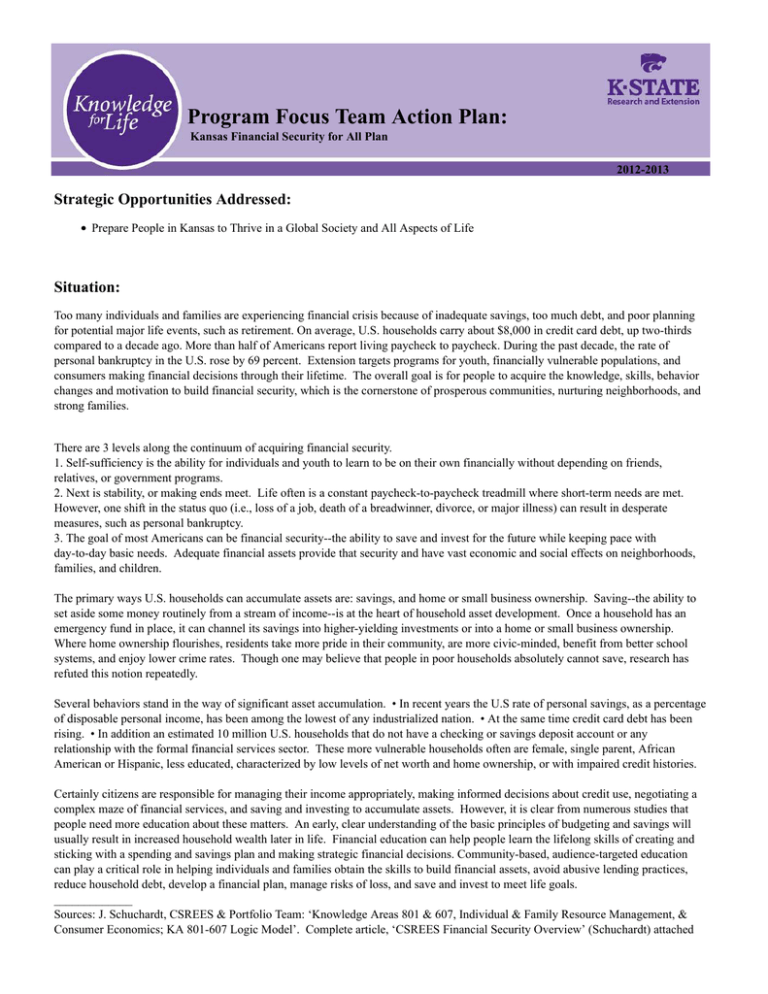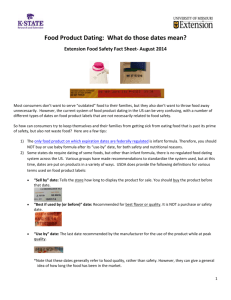Program Focus Team Action Plan: Strategic Opportunities Addressed:
advertisement

Program Focus Team Action Plan: Kansas Financial Security for All Plan 2012-2013 Strategic Opportunities Addressed: Prepare People in Kansas to Thrive in a Global Society and All Aspects of Life Situation: Too many individuals and families are experiencing financial crisis because of inadequate savings, too much debt, and poor planning for potential major life events, such as retirement. On average, U.S. households carry about $8,000 in credit card debt, up two-thirds compared to a decade ago. More than half of Americans report living paycheck to paycheck. During the past decade, the rate of personal bankruptcy in the U.S. rose by 69 percent. Extension targets programs for youth, financially vulnerable populations, and consumers making financial decisions through their lifetime. The overall goal is for people to acquire the knowledge, skills, behavior changes and motivation to build financial security, which is the cornerstone of prosperous communities, nurturing neighborhoods, and strong families. There are 3 levels along the continuum of acquiring financial security. 1. Self-sufficiency is the ability for individuals and youth to learn to be on their own financially without depending on friends, relatives, or government programs. 2. Next is stability, or making ends meet. Life often is a constant paycheck-to-paycheck treadmill where short-term needs are met. However, one shift in the status quo (i.e., loss of a job, death of a breadwinner, divorce, or major illness) can result in desperate measures, such as personal bankruptcy. 3. The goal of most Americans can be financial security--the ability to save and invest for the future while keeping pace with day-to-day basic needs. Adequate financial assets provide that security and have vast economic and social effects on neighborhoods, families, and children. The primary ways U.S. households can accumulate assets are: savings, and home or small business ownership. Saving--the ability to set aside some money routinely from a stream of income--is at the heart of household asset development. Once a household has an emergency fund in place, it can channel its savings into higher-yielding investments or into a home or small business ownership. Where home ownership flourishes, residents take more pride in their community, are more civic-minded, benefit from better school systems, and enjoy lower crime rates. Though one may believe that people in poor households absolutely cannot save, research has refuted this notion repeatedly. Several behaviors stand in the way of significant asset accumulation. • In recent years the U.S rate of personal savings, as a percentage of disposable personal income, has been among the lowest of any industrialized nation. • At the same time credit card debt has been rising. • In addition an estimated 10 million U.S. households that do not have a checking or savings deposit account or any relationship with the formal financial services sector. These more vulnerable households often are female, single parent, African American or Hispanic, less educated, characterized by low levels of net worth and home ownership, or with impaired credit histories. Certainly citizens are responsible for managing their income appropriately, making informed decisions about credit use, negotiating a complex maze of financial services, and saving and investing to accumulate assets. However, it is clear from numerous studies that people need more education about these matters. An early, clear understanding of the basic principles of budgeting and savings will usually result in increased household wealth later in life. Financial education can help people learn the lifelong skills of creating and sticking with a spending and savings plan and making strategic financial decisions. Community-based, audience-targeted education can play a critical role in helping individuals and families obtain the skills to build financial assets, avoid abusive lending practices, reduce household debt, develop a financial plan, manage risks of loss, and save and invest to meet life goals. _____________ Sources: J. Schuchardt, CSREES & Portfolio Team: ‘Knowledge Areas 801 & 607, Individual & Family Resource Management, & Consumer Economics; KA 801-607 Logic Model’. Complete article, ‘CSREES Financial Security Overview’ (Schuchardt) attached or at http://www.csrees.usda.gov/financialsecurity.cfm Outcomes: Short-Term: Short Term Outcomes –What are the short term ‘Knowledge-learning’ results? Individuals and families gained knowledge related to: • financial management ‘best practices’ [KSRE financial website>staff corner>financial best practices] http://www.ksre.ksu.edu/FinancialManagement/p.aspx?tabid=43 • setting financial goals & planned action-steps to reach goals; • increased decision-making skills & confidence implementing one or more financial management best practices. • identifying emerging societal needs for financial security Evaluation Questions: • What knowledge do participants gain about financial management best practices, setting financial goals, and action steps, decisionmaking skills and/or societal needs for financial security? - After participating in a family resource management program, how many participants plan to take new actions to apply financial management best practices? Medium-Term: Medium Term Outcomes—What are the medium term Action/Behavior Change results? Individuals & families have: • developed action plans for financial security • used recommended financial management best practices, set &/or revised financial goals • take financial action by adopting one or more financial management best practices, such as reduced debt & increased savings. • awareness of how some current & proposed policies can influence financial behavior to increase financial security. Programs targeting Medium Term financial action: • Kansas Saves: [contact: E. Kiss] Youth Financial State Evaluation; Adult Evaluation Adults and Youth will: 1) make a commitment to ‘save or reduce debt’, and sign up to be a Kansas Saver, 2) Increase savings for current and retirement needs to meet specific goals and commitments: -- build an emergency fund in accessible cash saving account -- save a portion of or all tax refunds for goals; use refunds to pay down debt -- sign up for automatic employee saving payroll deduction opportunities -- set up automatic checking account transfers to savings accounts/other investments 3) Use wisely and/or reduce consumer & credit card debt to avoid interest and fees via -- manage payments promptly to avoid fees and elevated interest -- commit to reducing/stopping credit card usage -- commit to paying more than the ‘minimum payment’ due -- commit to establishing a repayment timeline on all accounts -- achieve a monthly balance which is either at zero or a low level. -- continue paying the monthly commitment payment to personal savings • Medicare and Low Income Subsidy Health Insurance: [contact: D. Burnett] Evaluation: template in K-PICS and Excel template available from http://www.ksre.ksu.edu/financialmanagement/ then click on Programs and select SHICK Eligible individuals and their family members will: -- understand insurance options to meet their health needs -- select adequate coverage -- reduce insurance costs while maintaining appropriate coverage -- reduce stress and anxiety over health care issues • Financial Education at Income Tax Time: [contact: C. Evans] Evaluation: template in K-PICS Annual season provides a financial teachable moment so that Taxpayers will : -- Save all or a portion of their tax refund -- to an emergency fund savings account, or to reduce existing consumer debt -- using the IRS automatic deposit to savings options -- Adjust w2 withholding amounts to provide: -- increased monthly income for household needs -- increased money to place in emergency funds or other saving tools which draw interest -- reduced income tax refund amounts that are only accessible during tax time • Legally Secure Your Financial Future: [contact: E. Kiss] Evaluation: http://www.ksre.ksu.edu/FinancialManagement/p.aspx?tabid=59 LSYFF is a national template program designed for Extension educators to facilitate using invited local experts. Planning guidelines and resources are provided on these topics: 1) Organize Your Important Household Papers, 2) Communicate Your Advance Directives for Health Care, and 3) Prepare Your Estate Plan. • Getting Organized 2011-2012 Signature Program: [contact: J. Rathbun] Progam: http://www.ksre.ksu.edu/FinancialManagement/p.aspx?tabid=1 Evaluation: template in K-PICS & for your reference at http://www.ksre.ksu.edu/FinancialManagement/p.aspx?tabid=77 Objectives: Participants will: • Identify and inventory important papers. • Organize home office space. • Organize and/or replace important papers. • Set realistic goals for getting organized • Get Financially Prepared! Take Steps Ahead of a Disaster 2013 FCS Lesson Series: [contact: J. Rathbun] Fact Sheet: http://www.ksre.ksu.edu/library/famec2/mf3055.pdf Leader's Guide: http://www.ksre.ksu.edu/library/famec2/mf3056.pdf Evaluation: template in K-PICS Objectives: Participants will: • increase knowledge of what a household inventory is, its value, and uses; • become familiar with resources for compiling and storing a household inventory; • learn the importance of having adequate insurance coverage; • understand the importance of creating a grab-and-go box in preparation for an emergency; and • learn the importance of creating a system to document damage, recovery, and expense efforts following a disaster. Evaluation Questions: • How many participants have developed action plans for financial security, set or revised their financial goals, reduced their debt, increased their savings or demonstrated other financial management best practices? • Do participant's planned financial actions reflect increased awareness of how current and proposed policies can impact their planned financial goals. Long-Term: Long Term Outcomes—What is the intended ultimate Condition impact? Human Capital Individuals & families across Kansas and the U.S. have: • Increased their rates of saving; investment for retirement • Decreased their risk of bankruptcy filings. • Decreased their outstanding consumer debt. • Increased family financial security. Civic Capital • Public financial policies are adopted which encourage and support household asset accumulation. Economic Capital • Financially secure households support increased individual & family wealth. • Financially secure households support increased economically viable communities. Assumptions - Evidence-based education can enable rural individuals & families to achieve financial self-sufficiency, stability, & life-time financial security. Americans can earn a living wage. Public policies encourage household asset-building. External Factors – Institutional commitment; volunteer and nonprofit participation; changing public and institutional priorities; economic conditions, including employment; coordination and cooperation with government entities and non-profit partners around policies affecting individual and family use of financial best practices. Prepared March 2009/Revised 8-2011--Carol Young & Esther Maddux Revised August 2012--Elizabeth Kiss, Susie Latta & Diane Burnett Evaluation Questions: • How many Kansas individuals and families have increased their financial security? • How many Kansas communities are economically viable? Outputs: Outputs/Participants — Who is the target audience? Extension: (in concert with federal target audiences as applicable to Kansas) • low-wealth households (often single parents, women, minorities, low levels of education, impaired credit histories) • individuals and families, including military individuals & families • employer partners to reach employees in the workplace • Medicare and Low Income Subsidy(LIS) eligible individuals • taxpayers • consumers • young adults 18-24, college, military • youth Outputs/Activities—What will you do to carry out the program? (national/state partners: America Saves-CFA, IRS, Medicare/SHICK-KDOA, NEFE, eXtension) Extension Activities: • Conduct a statewide needs assessment within PDC and Program Focus Teams (PFT) • Develop programs based on statewide needs/current issues; plan delivery, & evaluation components • Develop face-to-face and electronic training. • Strategies developed to track participation levels and behavior changes. • Promote the America Saves/Kansas Saves Campaign – Use ‘Save and Reduce Debt’ as a consistent social marketing message to support broad basic financial educational needs. • Provide health care insurance education to Medicare and Low Income Subsidy (LIS) eligible individuals and their families • Provide ‘save/reduce debt’ education during income tax refund season to take advantage of a significant nationwide financial teachable moment • Promote the national eXtension online Personal Finance resource for: 1) agent development opportunities and 2) public access to national experts and interactive resource information. • Promote youth development activities and curriculum resources that are based on the (JumpStart) National Standards in K-12 Personal Finance Education used by Kansas schools. • Link theoretical & applied research to practice. Plan Contacts: Kiss, Elizabeth - Assistant Professor , Family Studies and Human Services Latta, Susie - Extension Agent , Marshall County Extension Wood, Debra - Extension Agent , Geary County Extension

